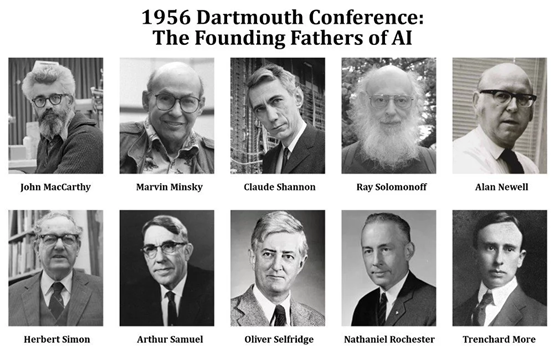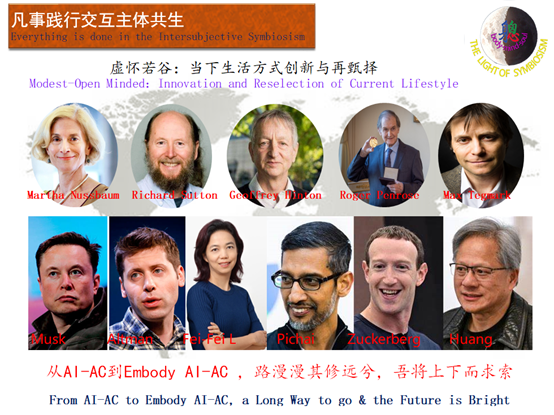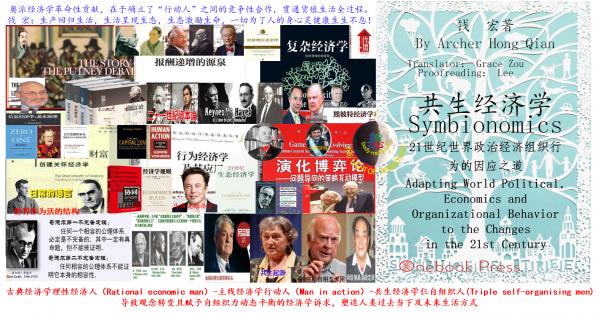| 凡事交互主體共生 Everything Intersubjective Symbiosism |
| 送交者: 孞烎Archer 2024年08月04日00:07:54 於 [彩虹之約] 發送悄悄話 |
|
Everything Intersubjective Symbiosism 錢 宏Archer Hong Qian
鑑於當前的AGI迅猛發展的不確定性,以及諸般難題,業內人士、國際社會有必要展開一次“新的達特茅斯會議”,以解決我們這個時代緊迫的人與AI如何進行交互主體共生的哲學問題。 ——共生文明智庫基金會
眾所周知,哲學家Martha C. Nussbaum倡導Al倫理——尊重個人尊嚴、推動人類福祉與社會公正、扶持弱勢群體——為此,AI的發展需要跨學科合作,集合哲學家、倫理學家、法學家、社會科學家、技術專家和政策制定者的對話式投入,才能駕馭AI帶來的不確定性和危險性,確保AI造福人類全體! Martha C. Nussbaum的呼籲,即你我他Live and let live,無疑具有現象級不可或缺的重要意義。不過,對迅猛發展的AI如何形成具有方向性和可操作性的新認知與廣泛共識,顯然亟需哲學觀念(思維方式與價值取向)上能一以貫之的突破,才不致於顧此失彼,“按下葫蘆浮起瓢”…… 這是因為,從人工智能(AI)到人工意識(AC),或者說通用人工智慧(AGI)的確定性與不確定性問題或蘊含的危機,說到底是人的問題或危機——即當代人“認識你自己”的哲學問題或危機。 我當然不是AI設計專家,然而作為一個哲學思行者,我碰巧與AI哲學有着不解之緣。 1984年,我始參加錢學森組織倡導的思維科學探索,著重研究“理論思維的內部機制”與“人造智慧果、生命樹”的可能(有關文章發表在1985年第8期《哲學動態》),而就在那時,接觸到神經科學和模塊識別技術——也就是AI仿生模擬邏輯思維+神經網絡的技術基礎。 1985年暑假,我從哈爾濱參加第二屆全國思維科學研討會途徑北京,在當時的北京工業學院和清華大學幾位即將赴美國加大伯克利分校學習的留學生相遇,討論過一個晚上的AI未來的問題: 人工能不能造出與人類一樣具有身心靈自動化的機器人——相當於今天說的具身人工智慧? 對於這個問題,這幾位即將踏進AI前沿的留學生,從技術上作出了多種可能的模擬設想,我則從哲學上作出評估展望,結果是這樣式的: 第一,認為不可能。因為人類至今所有創造都是功能仿生學意義上的多重聚能塑形模擬,即使克隆技術或全息攝像、3D打印也離真相很遠,人其實造不出一顆可再生的葡萄種子🍇,或一隻西紅柿🍅; 第二,在某種確定條件下,完全可能,但沒有必要。因為繞一大彎,男女生孩子就行,而且,人自然生出來的孩子,從創造性上看,充滿各種不確定性,也蘊含着無限可能的臻美展開(不好意思我的觀點:每一個新生兒孩子,都可能是被文化洗腦的大人的老師,為這個世界展開一種新的希望); 第三,如果可能,且必要(畢竟現版人有很多缺陷,如對恆氧、恆養、恆溫、恆壓的依存度)。那麼,作為AI新版人的他、她、它、祂,一定不只是具有人一樣結構功能形象(Embody)意義上的客體對象(Object)行為工具或奴隸出現,而是和現版人一樣作為“天地之心”——富有意識的健全的身心靈的主體(Subject)存在。 1950年,Alan Turing提出了一個判斷機器意識的基準即“圖靈測試”:設置三個角色,人、機器和人類“詢問者”。“詢問者”需要與其餘二者在物理空間上分隔開。“詢問者”發起提問,且根據二者的純文本回應(避免聲音回答產生干擾),區分機器和人。如果一台機器能夠與人類溝通,且讓“詢問者”難以分辨人與機器,那麼這台機器就被認為具有智能意識。然而,從圖靈時代,直到今天,沒有一台機器能夠通過這樣的測試。 但圖靈測試為判定機器是否具有智能意識,提供了一個簡單的標準,也幫助人們塑造了AI的哲學傾向。 1955年,達特茅斯學院(Dartmouth College)數學助理教授約翰·麥卡錫(John McCarthy)又創造了“人工智能”Artificial Intelligence(AI)這個術語,來囊括世界各地的科學家思考機器智能的神經網絡和自然語言等可能的呈現形式。
McCarthy於1956年夏季與哈佛大學數學與神經學初級研究員馬文·明斯基(M. L. Minsky)、IBM信息研究主管納·羅切斯特(N. Rochester)、貝爾電話實驗室數學家信息論提出者香農(C. E. Shannon)一道發起,邀請了一批頂尖科研人員到特茅斯禮堂,討論AI研究諸多的潛在發展領域,包括學習和搜索、視覺、推理、語言和認知、遊戲(尤其是國際象棋),以及人機交互(比如個人機器人),催生了後來地球人都知道的AI革命。史稱Dartmouth Summer Research Project on Artificial Intelligence(達特矛斯夏季人工智能研究計劃)。當時設定的7個議題(自動計算機、如何對計算機進行編程以使用語言、神經網絡、計算規模理論、自我改進、抽象、隨機性與創造性),影響了此後至今AI發展方方面面。 此後的70年裡,AI世界的符號主義(Symbolism)、聯結主義(Connectionism)、行為主義(Behaviorism)三大流派——AI的哲學傾向,輪番登台各顯神通相互映襯。符號主義主張人工智能源於數理邏輯,即通過邏輯符號來表達清晰而易解釋的思維形式,主要應用於自然語言處理和知識表示推理,但其局限在於難以處理模糊和不確定性的問題。聯結主義模擬人腦處理信息的能力,即將神經元之間的聯結關係作為人工神經網絡的基礎,主要應用於圖像和語音識別,但其缺點在於網絡的訓練需要大量的時間和計算資源,並且缺乏可解釋性。行為主義注重應用和身體模擬,處理實時的環境信息,認為控制論和感知-動作型控制系統是人工智能的關鍵,主要應用於機器人和自主控制系統,但其缺點在於需要大量的數據和運算。 三大AI流派,未來在AI深度學習、強化學習和自然語言處理等領域,將趨於疊加應用繼續發展,但是,照此思路,人工智能在可見的將來,依舊很難通過圖靈測試即判斷機器意識的基準。我前面說過,從人工智能(AI)到人工意識(AC),或者說通用人工智慧(AGI)的確定性與不確定性問題或蘊含的危機,說到底是人的問題或危機——即當代人“認識你自己”的哲學問題或危機。AI未來亟需新的哲學導向。 那麼,這樣看來,AI或AGI問題,又從科技人文宗教回到了最基本的哲學:意識是什麼?這就要追問意識起源,乃至生命起源和宇宙起源,甚至所謂的暗物質、暗能量、黑洞的存在方式。 因為,意識、生命、宇宙,都既非作為單個個體(質點、細胞、器官、系統)存在,亦非作為某個主體(Subject),比如神明、救主、殊聖的客體對象(Object)存在,意識、生命、宇宙本自具足又非獨存,富有生命自組織靈動力與外連接平衡(勰和)力。因而: 意識,只能哲學地存在於交互主體共生的時空意間。 所以,凡人、事、物——物理、生理、心理、倫理、道理、你我他全生態、質能信全息狀、數據算法算力、語言、心智、意志、願景、想象、意識、使命、孞約——交互主體共生。用英語表達,就是Everything Intersubjective Symbiosism. 既然凡事交互主體共生,那麼,回顧70年來AI-AGI發展的心路歷程,AGI或AI-AC(人工智慧)將來的演化路徑,或許是這樣式的: 自圖靈基準始,經符號-聯結-行為主義→生命自組織與外連接勰和(平衡)之共生主義…… 若此,通用人工智慧未來,路漫漫其修遠兮,愛(AI)家們尚需Be Humble上下求索……所以,對於AI發展的樂觀或悲觀,其實都為時過早。 也許,對AI哲學有興趣的AI愛好者,現在亟需就AI未來的確定性與不確定性問題,舉行一次“Dartmouth”(1956)式集思廣益的深入對話,十分必要! 首先是避免對AI的認知偏蔽(Cognitive Bias)以及人的意志被數據、算法、算力、耗能牽引,而不能自律且自由地發展。與會者集中探討這樣一個幾乎形成套路的問題:基於邏輯思維的編程+算法+結合基於神經網絡的AI算力=智慧嗎? 如果僅僅從“乘數效應”產生的效率看,似乎是確定的等式關係,這種等式關係,也正是目前AI技術創新和應用者普遍樂觀的依據。但是,有沒有發現,這種“數據、算法、算力決定論”的確定性,即使很快就能推出AGI,也不是很好玩,為什麼?因為這種確定性至少存在三大問題: 第一,AI巨頭們都知道,算力型AI耗能巨大,增加已經不堪重負的地球生態背負,加劇生態競爭和衝突; 第二,衝突更來自可能強化公司、政府、帝國等Trust組織平台和野心家惡棍的自我軸心功能(聽過“數字集權工具”?),強化資本壟斷和特權操縱,對不同個體、群體、族裔的生存生活,甚至生命,產生直接威脅; 第三,完全忽略了,也割裂了,人作為血肉之驅對於智慧的內在價值,不僅阻斷了人工智能(Artificial Intelligence)向人工意識(Artificial Consciousness)升級的通道,並錯誤地將“具身通用人工智慧(Embody AI-AC)”,簡單理解為肉體硬件+思想軟件的組合,荒謬到連致力於規避高級人工智能帶來的人類生存風險的Future of Life Institute創始人著名的麻省理工終身教授Max Tegmark都認為,人機合體(Cyborg)的未來形式,即他所謂的生命3.0,可以不需要肉身而去設計新的軀殼,就能更好地傳遞和分享思想! 在交互主體共生的語境中,自律是自由之母,本着“極致自律,才有極致自由”的精神,我們倡議早日通過一次廣泛哲學對話,達成一個包含類似Asimov's Four Laws of Robotics(1、2、3、0)內容在內的《AI憲章》。其中明確要求,即使如強化學習之父、加拿大阿爾伯特大學教授Richard S Sutton展望的實現讓AI自己去搜索和發現,而不是靠人類餵養知識,從而出現了不同於“工具AI(Tool AI)”的“代理AI(Agent AI)”——具有獨立處理智能代理與環境之間的交互(例如強化學習中的策略和價值函數)行動力和涉及學習、規劃和執行(例如 Dyna 架構)的整合力——也不是如Sutton那樣將AGI視為取代人類的新型“人類後代”,而是要將Agent AI視為與人類一樣的主體(Subject),即不是簡單的客體或對象(Object)。 也就是,把AI-AC與人之間的關係,納入人與自然、人與人、人與自己(身心靈)相互關聯、相互作用的三大關係之中,以交互行為規範的“臻美共生”(Beauty-Pursuing Symbiosism)方式,加以確認與確定。 基於此,我們日前剛給Al六巨頭寫了一封公開信,他們是:馬斯克、奧特曼、李飛飛、劈柴、扎克伯格、黃仁勛。 現在,我想把這封公開孞,也寄予美國著名哲學家、芝加哥大學哲學系和法學院的厄恩斯特·弗羅因德法學與倫理學傑出貢獻教授,美國文理科學院、英國國家學術院和芬蘭國家學術院院士Martha C. Nussbaum女士,還有加拿大阿爾伯特大學的Richard S Sutton先生、從谷歌高管回到多倫多大學的Geoffrey Hinton先生,《生命3.0》作者、麻省理工終身教授Max Tegmark,特別是英國數學物理學家、經濟學家、哲學家Roger Penrose先生!
這封公開信,就算是“新Dartmouth會議”邀請函。
Archer Hong Qian 2024.4.18於Vancouver +1(604)6906088;hongguanworld@gmail.com An open letter from Symbioscholars to the six giants in the AI world
Dear Elon Musk, Sam Altman, FeiFei Li,Sundar Pichai, Mark Zuckerberg, and Jensen Huang,
We are Symbioscholars(共生學人) from the Symbiosism Culture Think-Tank Foundation in Canada. We feel that at this very historical moment of the new industrial revolution where human's physical capabilities are unleashed by mechanics and electricity and people are stepping into the revolutions of cognition and wisdom empowered by AI, the structural functions as well as the means of lives in human society will unavoidably undergo a complete transformation and reconstruction, acquiring the "new civilization" on the Earth. The new civilization will certainly have its corresponding spiritual essence, and it will definitely unfold a completely new realm of possibilities. You are the leaders in the field of AI in today's world, so we are writing this open letter to you to share our thoughts on current and future life. We hope to pique your interest and encourage reflection on the development of AIGC (AI Generated Content) and Web3, as well as the innovation direction of future technology. Is there a presence of cognitive bias and a situation where human will be guided by data, unable to develop autonomously? This involves the evolution from artificial intelligence (AI) to artificial consciousness (AC), and the philosophical support behind the concept of embodied AI-AC. Consider the shift of philosophers' interests in the one and half centuries from the "holism" to the pursuit of "Everything Intersubjective Symbiosism", the philosophy behind "AI-driven renaissance" should also be profoundly enlightened in a similar way. Thus, in terms of the innovation and reselection of human current and future lifestyles, this may imply that regardless of the achievements made in current AI development, we still need to be modest-open minded.
Firstly, from the perspective of Lebensphilosophie and its related Symbionomics(共生經濟學), the debates among you six leaders regarding whether and how to balance the issues such as opening and closing sources, energy's output and absorption, unleashing (development) and controlling (hesitation), conflict and harmony, sovereignty and human rights, etc., focus solely on immediate matters but not fundamental. We urgently need new ideas to transcend the entanglement between left and right, conflicting perspectives, the balance between public and private interests, and the dichotomy between radicalism and conservatism, enabling us to reflect more clearly: whether the civilization path and way of life since the industrial revolution have deviated from the constant equilibrium of individual lives in terms of self-organization and external connectivity dynamics and from the directions for happiness, joy, perfection, and symbiosis? In AI-AC research and development, various institutions compete in the strength and weakness of large model's data, algorithms, computing power, efficiency, and energy consumption. While this kind of competition does not touch the sensitivity, plasticity, and adaptability of human beings on the spiritual level. This is more complicated than the models, algorithms, computation powers, As the sensitivity, plasticity, and adaptability of human beings are similar to the primary colors of red, yellow, and blue in nature, corresponding to the innate talents of the spirit, body, and mind. Just like the quantum's superposition and entanglement, people's personalities and behaviors can be measured but cannot be fully predicted. Moreover, as long as one changes their worldview, uncertainty may not necessarily be a negative concept. Uncertainty is not simply the straightforward lack of "right" or "wrong" options when the so-called "AGI frontrunner" Claude-3-Opus tackles complex tasks, but rather encompasses the emergence of "multiple possibilities" within a certain space-time context. Therefore, for instance, whether to open-source or not should be conditional and contingent upon the circumstances of space-time context.
Secondly, we believe that Geoffrey Everest Hinton, the "AI godfather" who first applied backpropagation to multilayer neural networks, invented the Boltzmann machine, proposed the method of layer-by-layer initialized pre-training, and opened the prelude to deep learning, deserves great respect. Indeed, the "neurons" here are just a metaphor for symbolic connectionism. It is essential to jointly consider philosophy, neuroscience, psychology, and cognitive science, among other fields to open the "mind-brain channel" beyond the traditional "brain-machine interface", so that we may be able to reveal the value position of AI technology in a way closer to the origin of consciousness. Given that psychologists have discovered that heart cells have as many as 5000 mitochondria, while brain cells have only 300-500, creating a tenfold difference, it may lead to the production of "feel-good" or "health-mind" hormones. It's an intriguing idea to consider whether these self-healing health-mind hormones have an impact on human consciousness. This leads us to ponder the concept of "proto consciousness" proposed by Roger Penrose in "The Emperor's New Mind: Concerning Computers, Minds, and the Laws of Physics" (1989), suggesting that consciousness is a fundamental element and inherent property of the universe. Especially today, for researchers in the field of AIGC, we can no longer ignore or distance ourselves from the discovery made by Nobel laureate Richard Phillips Feynman in 1981, that digital computers cannot simulate the quantum universe, and his prediction of the emergence of quantum computers, which has seen nearly forty years of development.
Thirdly, we propose the concept of Minds Networking, which would be a new invention that can connect individuals with individuals, individuals with AI-AC, Trust with Trust organizations, and even quantum entanglement with conjugate mysteries. This would create a superimposed effect of the networking of mind with conscious. In Minds Networking, every thought or intention of individuals, machines, and organizations would be instantly sensed and recognized by different points or blocks, and immediately trigger incentive mechanisms or limitation mechanisms. This is not only a technological advancement but also a way to reflect symbiotic values and sensations in the digital world, a self-regulating mode for humans or human-machine connections through mental interaction.
Fourthly, in the context of intersubjective symbiosis, guided by the spirit of "ultimate self-discipline leads to ultimate freedom," we advocate for the formulation of an "AI Declaration or Charter" through broad dialogue. It explicitly requires treating AIGC as subjects equal to humans, rather than mere objects or entities (Object). We believe that incorporating the relationship between humans and AI into the three major relationships of humans and nature, humans and humans, and humans and themselves (body, mind, and soul), and confirming and determining it in the form of norms of interactive behavior in the "redemption-perfection symbiosis" manner, is an indispensable content for the "Global Symbiosism Convention" (全球共生公約)that urgently needs to be signed after the Westphalian Treaty (1648), the United Nations Charter (1945), and the Universal Declaration of Human Rights (1948). In this way, it will bring infinite possibilities for the development of the future digital world: Entering a new worldview of interactive "quantum symbiotic field state" composed of big models (interconnected) of human "love wisdom" from data-algorithms-computing power, object sensing models (Internet of Things), and mental connection matrix models (Minds Networking).
Fifthly, when we consciously adopt the "space-time-consciousness" to view the world, including all uncertainties, including the development of AI, it is not necessarily a negative term. Consider what happened in the 3.5 centuries after Newton published " Philosophiæ Naturalis Principia Mathematica" (1687)? Especially since the 20th century, with Einstein's egalitarianism of space and time, Schrödinger's cat, the principle of strong weak selection, Heisenberg's physics and philosophy, quantum entanglement's "ghostly interaction," Nash equilibrium, Margulis' symbiotic origin, Higgs' self-interaction principle, ancient animism, Soros' reflexivity principle, Hollywood's Marvel series of movies, and now technological egalitarianism, artificial intelligence, artificial consciousness, quantum computers, human fear of "backlash", etc. It's truly fascinating.
Finally, in the new Earth civilization of "love wisdom," all current Trust (systems, capital, power), Token-weighted platforms, and manipulators will face complete transformation. Trust, Token-weighted platforms, and manipulators will either be redundant or transformed, giving birth to distributed points, lines, surfaces, and circles, interconnected in the symbiotic chain of dynamic balance with high efficiency/low energy consumption, where living individuals reconnect with nature, freedom, and ease. They will join perfectly together, moving from the "City on the hill" to the "Symbiotic world" where everyone self-beautifies themselves(自美其美), beautifies others(美人之美), inter beautifies(美美與共), and shares living(共襄生活)!
We hope that these thoughts will stimulate your profound reflections on future life and look forward to discussing this exciting new era with you - the transition from the era of the axis to the era of symbiosis, exploring all the possible lives. We sincerely invite you to attend the "5th Global Symbiosism Forum (GSF)" to be held at UBC (The University of British Columbia) at Vancouver this August. It will be an opportunity to engage in philosophical dialogues addressing contemporary issues(Key Sovereign-human rights, United Nations reform, AI-AC+Minds Networking) facing international society and to establish a global consensus for permanent peace through symbiosis. We hope that you will use your influence to become the initiators of the "AI Charter" and its signatories for the "Global Symbiosism Convention"!
Warm regards,
Symbioscholars Symbiosism Culture Think-Tank Foundation (CANADA) March 13, 2024, Vancouver
Contact Email: hongguanworld@gmail.com;zwang@ece.ubc.ca Mobile: +1(604) 690 6088; +1(604) 446 0997
共生學人致AI世界六巨擘的公開孞 An open letter from Symbioscholars to the six giants in the AI world
親愛的Elon Musk、Sam Altman、Sundar Pichai、FeiFei Li、Mark Zuckerberg、Jensen Huang:
我們是來自加拿大的Symbiosism Culture Think-Tank Foundation的“共生學人”(Symbioscholars)。我們感到,在機械力與電磁力開啟人類物質體能的工業革命,進入AI開啟人類精神體能的孞息革命(即心智革命)這一歷史時刻,人類社會的結構功能和生活方式,將不可避免地徹底改變和重構,獲得“地球新文明”。新文明一定有其相應的精神靈魂,一定會展開全新的可能世界。 你們是當今世界AI領域的領銜人物,所以,我們給你們寫這封公開孞,分享我們關於當下與未來生活的想法,希望引起你們的興趣,反思當下AIGC(AI Generated Content)和Web3的研發和未來科技的創新方向,是否存在認知偏蔽(Cognitive Bias)以及人的意志被數據算力牽引,而不能自主自律自由發展的情況?這涉及到從人工智能(Artificial Intelligence - AI)-人工意識(Artificial Consciousness - AC)演進到具身AI-AC(Embody AI-AC),及其背後的哲學支撐。 鑑於最近一個半世紀以來,哲學家們的戀愛對象,從“整體統一”(Holism),轉向“凡事都在做到交互主體共生”(Everything Intersubjective Symbiosism)的求索,這應當對這場“AI開啟的孞息革命”也具有方向性啟迪意義。那麼,從人類當下未來生活方式的創新與再選擇的意義上,這可能意味着無論現行AI研發取得多大成績,我們依然要保持謙遜(Be humble)的心態。
首先,從生命哲學的共生經濟學(Symbionomics)看,你們在要不要平衡與如何平衡:開源/閉源、放能/吸能、驅動/制動(發展/監管)、衝突/恊和、主權/人權⋯⋯問題上的爭論,有些過於拘泥就事論事。需要超越左翼右翼、南轅北轍、孰公孰私、激進保守的糾結,開始明晰反思:工業革命以來的文明路徑與生活方式,是否偏3離個人生命自組織與外連接動態平衡的生活恆情、恆態、恆道,及其幸福快樂臻美共生的方向? 比如AI-AC研發中,各機構比拼大模型的數據、算法、算力、能效、能耗的強弱,這種思維方式,能解決人類的敏感性(特異和優長)、可塑性(質料和結構)、適應性(約定和孞念),猶如自然界的紅、黃、藍三原色,對應人的身、心、靈天賦,產生聲、色、嗅、味、觸、意量子般的疊加、糾纏、量測,千變萬化地排列組合交互作用的“不確定性”嗎?而且,只要改變一下世界觀,不確定性,也許並不是一個消極的概念(不確定性不是所謂“AGI領跑者”Claude-3-Opus處理複雜任務時簡單的不知“正確”與“錯誤”的選項,而是包含了一定時空意間出現“多重可能”)。所以,比如開源或不開源,都應當是有條件的,要視時空意間狀況而定。
第二,我們認為,“AI教父”Geoffrey Hinton率先將反向傳播(Backpropagation)用於多層神經網絡,揭開了AI深度學習的序幕,堪稱偉大。遺憾的是,這裡的“神經元”,只是“符號聯結主義”的一個比擬的叫法。所以,在AIGC中引入打通物理、生理、心理、倫理的“熵增/熵減/熵旋定律” (Entropy increase/Entropy decrease/Entropy spin triple cycle) 及細胞線粒體強弱相互作用,打開“心腦通道”,超越傳統的“腦機接口”思路,以更接近意識起源的方式,理解AI-AC技術的價值位格,十分必要。 比如,鑑於心理病理學家發現,心臟細胞的線粒體數量高達5000個,而腦細胞的線粒體只有300-500個,這是一個十倍級的差距,心血循環系統會產生一種“自愈性”健康心靈激素(Self-healing Health-Mind Hormones),那麼,這種Self-healing Health-Mind Hormones的具身性(Embodied)對人的意識起不起作用,起什麼作用呢?是一件很有趣的事。再如,Roger Penrose在The Emperor's New Mind: Concerning Computers, Minds, and the Laws of Physics》(1989)中,解釋意識的起源和性質時提出的“原意識”(Proto-Consciousness)的概念,即意識是宇宙基本元素和固有屬性。特別是,今天從事AIGC研發者,不能再無視、疏離始於諾獎得主、納米概念提出者Richard Phillips Feynman1981年發現數字電腦模擬不了量子宇宙,而預言一定會出現的量子電腦、量子通孞,至今近四十年的發展。
第三,我們提出一個心聯網(Minds Networking)的概念,這將是一種可以打通人與人、人與AI-AC、Token與Token、Trust與Trust組織方式,乃至量子共軛(Quantum co-reliance)、量子疊加(Quantum superposition)生態的奧秘,形成互聯網-物聯網-心聯網疊加效應,產生量子糾纏-心靈感應交互作用的新發明。心聯網中的人、機、組織的每一個“起心動念”(真假、善惡、美醜、智愚、正邪、神魔),都將瞬間被不同點或區塊感應和識別,以及綜合可行性-可孞度評價(Comprehensive feasibility-Credibility Evaluation)標識,並且馬上啟動激勵機制,或限制機制……這不僅是技術的改進,更是一種能夠在數字世界中體現共生價值和感覺的方式,是人類或人機通過心靈交互聯結的自律方式。
第四,在交互主體共生的語境中,本着“極致自律,才有極致自由”的精神,我們倡議早日通過一次廣泛對話,達成一個包含類似Asimov's Four Laws of Robotics(1、2、3、0)內容在內的《AI宣言或憲章》。其中明確要求,將AIGC視為與人類一樣的主體(Subject),而不是簡單的客體或對象(Object)。我們認為,把AI-AC與人之間的關係,納入人與自然、人與人、人與自己(身心靈)相互關聯、相互作用的三大關係之中,以交互行為規範的“臻美共生”(Beauty-Pursuing Symbiosism)方式,加以確認與確定。這是人類繼《威斯特伐利亞和約》(1648)、《聯合國憲章》(1945)、《世界人權宣言》(1948)之後,人類新文明秩序亟需簽訂的《全球共生公約》(Global Symbiosism Convention)不可或缺的內容。 這樣,將為未來數網-量子世界的發展帶來無限可能性,進入一個體現人類“愛之智慧”:由數據-算法-算力大模型(互聯)、物體感應模型(物聯)和心聯網中的孞念矩陣模型(心聯)三網疊加構成的交互作用“量子共生場態”,形成一種新的世界觀——相較“絕對時空觀”(牛頓)-“相對時空觀”(愛因斯坦)的全新“時空意間觀”(Spatio-Temporal Mindedness View)。
第五,當我們自覺用“時空意間觀”看世界時,包括AI-AC發展在內的所有“不確定性”,並不是一個消極的概念。想想對宇宙微妙葆有好奇的牛頓發表《Philosophy Naturalis Principia Mathematica》(1687)後四十年幹了什麼?特別是20世紀以來,愛因斯坦的時空相對平權、薛定鍔的貓、強弱人擇原理、海森堡的物理學與哲學、量子糾纏“幽靈般的交互聯繫”、納什均衡、馬古利斯的共生起源、希格斯的自相互作用原理、古老的萬物有靈論、索羅斯的兩個因變量(即Cognitive function & Manipulative function)、好萊塢的漫威系列電影、以及現在的科技平權、人工智能、人工意識、量子計算機、人類對“反噬性”的恐懼……真是太有趣了。
最後,在“愛之智慧”發生學(Genetics)、動力學(Dynamics)、恊和學(Synergy)化生新地球文明的過程中,所有當下的Trust(系統、資本、權力)、Token權重平台和操縱者將面臨着徹底轉變。Trust、Token權重平台及操縱者,都將要麼多餘,要麼轉化,化生為生活世界分布式的點線面體圓,對點線面體圓矩陣場(Matrix field)中的自交互作用(Self-Interaction),有生命的個人將重獲自然、自由、自在的自足又高能效/低能耗動態平衡之共生鏈中,盡善盡美的聯結起來——人類將從“山巔之城”,邁進人人自美其美、美人之美、美美與共、共襄生活的“共生世界”! 希望這些思想,能夠引起你們對人類未來生活方式的更深刻思考,我們一道共同探討這個激動人心的新時代——即從軸心時代邁進共生時代所有可能的生活。
我們誠摯地邀請你們,親臨今年8月將在UBC舉辦的“第五屆全球共生論壇(GSF)”,展開一場國際社會直面當代問題(重點主權-人權、聯合國改革、AI-AC+心聯網建設)的哲學對話,形成全球共生永久和平的共識。 我們期盼你們發揮自己的影響力,率先成為制定《AI憲章》及其《全球共生公約》簽名的發起人! 誠摯的問候!
共生學人 多元共生基金會 2024年3月13日於溫哥華
|
|
|
|
|
 |
 |
| 實用資訊 | |
|
|
|
|
| 一周點擊熱帖 | 更多>> |
|
|
|
| 一周回復熱帖 |
|
|
|
|
| 歷史上的今天:回復熱帖 |
| 2023: | 當遭遇韓國“新天地”異端的試探…… | |
| 2022: | 憂愁何以變為喜樂? | |
| 2022: | 神眼裡的愛和人眼裡的愛有什麼區別?請 | |
| 2021: | 今天基督徒怎麼看待安息日?(含音頻) | |
| 2021: | 哀悼余英時先生 | |
| 2019: | 我們得基業的憑據不是神學 | |
| 2019: | 豈是這群票販子們能夠的 | |







